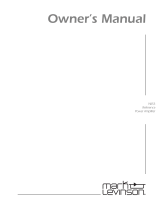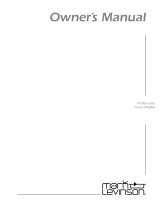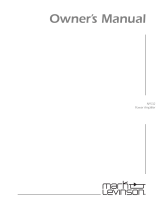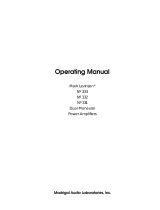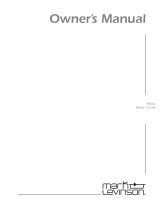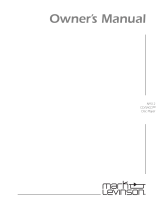Page is loading ...

N
o
53
N
o
532
Serial Protocol
Serial Protocol

TM
FCC Notice
This equipment has been tested and found to comply with the limits for a Class B digital device,
pursuant to Part 15 of the FCC Rules. These limits are designed to provide reasonable protection
against harmful interference in a residential installation. This equipment generates, uses and can
radiate radio frequency energy and, if not installed and used in accordance with the instructions,
may cause harmful interference to radio communications. However, there is no guarantee that
interference will not occur in a particular installation. If this equipment does cause harmful
interference to radio or television reception, which can be determined by turning the equipment off
and on, the user is encouraged to try to correct the interference by one or more of the following
measures:
• Reorient or relocate the receiving antenna.
• Increase the separation between the equipment and the receiver.
• Connect the equipment into an outlet on a circuit different from that to which the receiver is
connected.
• Consult the dealer or an experienced radio/TV technician for help.
Caution!
Changes or modifications not expressly approved by the party responsible for compliance could
void the user’s authority to operate the equipment.
Canada
This Class B digital apparatus complies with Canadian ICES-003.
Cet appareil numérique de la Classe B est conforme à la norme NMB-003 du Canada.
For customer service and product
shipment information, refer to the
www.marklevinson.com Web site.
Part No. 070-18998| Rev 1 |10/08
Mark Levinson and the Mark Levinson logo are trademarks of Harman
International Industries, Incorporated, in the United States and/or other
countries.
Microsoft and Windows are registered trademarks of Microsoft Corporation in
the United States and/or other countries.
Other company and product names may be trademarks of the respective
companies with which they are associated.
©2008 Harman International Industries, Incorporated. All rights reserved.
This document should not be construed as a commitment on the part of
Harman International Industries, Incorporated. The information it contains is
subject to change without notice. Harman International Industries,
Incorporated assumes no responsibility for errors that may appear within this
document.

Mark Levinson N
o
5 Series Amplifiers Serial Communications Protocol
1 Documents 4
1.1 Change List 4
2 Definitions, Acronyms, and Abbreviations 4
3 General Description 5
4 Ethernet Port & Cable Configuration 5
4.1 Physical Connection using Ethernet Cables 5
5 Message Formats and Examples 6
5.1 Format of the Message Fields 6
5.2 Incoming Messages 7
5.3 Outgoing Messages 7
5.3.1 RSP – Response to Command Request 7
5.3.2 NTF – Notification of System Action 7
5.4 Example Request - RQST 8
5.5 Example Response - RSP 8
5.6 Example Notification - NTF 8
6 RQST Error Responses and Examples 8
7 External Protocol Commands 10
7.1 DSPLY – This command only applicable to the No53 Amplifier 10
7.2 FAULT 11
7.3 NOP 11
7.4 HWSTATUS 11
7.5 PWR 12
7.6 TEMP 12
8 Critical Fault Notifications 13
9 Notification Factory Defaults 13
3

N
o
5 Series Amplifiers Serial Communications Protocol Mark Levinson
1 Documents
The following documents should also be used with this document to understand how this protocol can be
used with the N
o
5 Series Amplifiers.
070-18285 N
o
53 Reference Monaural Power Amplifier Owner’s Manual
070-18979 N
o
532 Dual Monaural Power Amplifier Owner’s Manual
1.1 Change List
No changes have been made.
2 Definitions, Acronyms, and Abbreviations
\r represents the ASCII new line control character (0x0D)
: External Protocol String Field Separator
, External Protocol String Field Parameter Separator for multiple parameters
ACK Acknowledge
AV Audio Video System generated response
CMD Command
CS Control Source
EOP End of Packet
HOST The device initiating or receiving the serial communication packets to/from the
amplifier.
ML Mark Levinson
N
o
5xx The Mark Levinson amplifier product receiving or transmitting the serial
communication packets to/from the HOST.
NAK/NACK No Acknowledge
NTF Notification
PARAM Parameter
RM Resource Manager
RQST Request
RSP Response
SOP Start of Packet
SPLUT Serial Protocol Lookup Table
SPG Serial Protocol Guidelines
UI User Interaction
User Parameter A user changeable variable that stores a specific value that describes an
operating condition for the amplifier.
4

Mark Levinson N
o
5 Series Amplifiers Serial Communications Protocol
3 General Description
An external host controller can use the external protocol to control and monitor the operation of the N
o
5
Series Power Amplifiers. The protocol consists of simple ASCII character set based commands, which
are passed to the amplifier as command packets via the Ethernet port. The amplifier will reply to
command packets with an acknowledgement to signify that the command has been recognized and acted
upon.
EXTERNAL
HOST
(Controller)
N
o
4 Ethernet Port & Cable Configuration
The N
o
5 series power amplifiers are capable of obtaining a dynamically allocated IP address when
connected to a DHCP server and the Network User Options are configured to use the DHCP server
(default behavior). The DHCP setting can be modified via the internal Web page of the amplifier. Refer
to the amplifier’s user manual for further instructions.
The amplifier setup for Ethernet Control is defaulted to Auto-Negotiate and recommends the end point to
also be configured for Auto-Negotiation. However, the amplifiers are capable of:
• 10/100 BaseT
• Half/Full-duplex
• flow control
• Pause control
Note: These parameters are NOT user-adjustable.
4.1 Physical Connection using Ethernet Cables
If using a Direct-to-Ethernet capable Component, use a Crossover Ethernet Cable.
If using a router or switch, use a straight through Ethernet Cable.
5 Series
Power amplifier
Ethernet cable
PC/Controller
(TCP Client)
Mark Levinson
Power Amplifier
Crossover
Cable
Controller
(TCP Client)
Mark Levinson
Power Amplifier
Straight
Cable
Router
Straight
Cable
5

N
o
5 Series Amplifiers Serial Communications Protocol Mark Levinson
5 Message Formats and Examples
The external protocol consists of a structured format string with specific fields used to indicate:
Message type
Source of the command
Command
Status/Parameter
Messages can be transmitted to (incoming) and received from (outgoing) the amplifier to facilitate system
control via the Ethernet connection.
5.1 Format of the Message Fields
All incoming and outgoing messages must use the following format:
HDR:SRC:CMD:PARAM\r
where:
HDR The Header field specifies the type of message:
RQST – incoming request
RSP – outgoing response
NTF – outgoing notification.
SRC The Source field specifies the source of the message:
CS – message from a Control Source
UI – message from a User Interaction
AV – used by notifications to indicate and event was caused by the
component without user interaction.
CMD The Command field specifies the command selected from the External
Protocol Commands table to invoke the desired functionality.
PARAM The Parameter field specifies the selected parameter from the External
Protocol Commands table to achieve the desired effect.
Fields are separated by a colon “:” and messages are terminated with a ‘\r’ control
character (0x0d).
All fields, commands and associated parameters are case sensitive and must be entered as
listed in the External Protocol Commands table. Do not insert spaces in message sequences,
unless they are indicated in the table.
Maximum message size is 60 characters, including the line ending ASCII control character ‘\r’
(0x0D).
When an incoming or outgoing message uses more than one parameter, the individual parameters must
be separated by commas.
HDR:SRC:CMD:PARAM1,PARAM2,PARAM3,…\r
When an incoming command requires multiple parameters per request (RQST), ALL parameters for the
given command must be entered AND in the order presented in the External Protocol Commands table,
as the descriptors are not utilized in the parameter field of the command/response string. The response
message also follows these guidelines.
6

Mark Levinson N
o
5 Series Amplifiers Serial Communications Protocol
5.2 Incoming Messages
The Header Field (1st field) of every external protocol string indicates the type of message contained
within the transmitted string. All incoming messages to the amplifier contain the string “RQST” in the
header field. Any other string in the header field indicates an outgoing message. The control source that
issued the Request (RQST) expects a reply within 500ms after receipt of the string to indicate that the
message was received. This response can be an acknowledgement (ACK), the requested action if a data
parameter was requested, or a WAIT to indicate the system has received the command but needs
additional time to process the request.
NOTE: When an incoming request is received, the system acknowledges receipt of the string within
500ms of receiving the incoming message.
5.3 Outgoing Messages
Outgoing Messages are generated to acknowledge an incoming request, to provide requested
information, or to inform of a system action occurring. As with an incoming message, the Header field is
used to indicate the type of message contained within the string. Outgoing messages will be a response
(RSP) to a request or a system generated notification (NTF) message.
5.3.1 RSP – Response to Command Request
An outgoing RSP will be generated as the result of an incoming RQST. In most cases the response is an
acknowledgement (ACK) unless the request is a query “?”. In the case of a query, the RSP contains the
requested parameter, rather than an ACK.
5.3.2 NTF – Notification of System Action
An NTF is generated as the result of a system action occurring. When commands are issued to the
system, they are placed in a queue in the order they are received. When the command is acted upon and
the requested action has completed or occurred, a notification is generated within the system. If enabled,
the notifications are sent if a user manually manipulates the front panel buttons or controls, presses IR
keys on the remote control, issues an RQST via External Protocol to instruct the system to perform an
action, or if a system fault is detected.
When a NTF event occurs, the source field indicates the source of the event:
UI (user interaction)
AV (component generated) fault
It’s important to note that Notifications are only sent to the Controller if they are enabled. See the
Notification Factory Defaults section of this document for the factory default settings. See the External
Protocol Commands section in this document for more information.
Also, as commands are issued to change the state of a notification event (enable it or disable it), the
external protocol notification database is updated to store this new state information, so that user
configured notification states are automatically restored when the amplifier is power cycled. However, the
user configured states are reset to Factory Defaults at any time that the factory default settings are
restored.
7

N
o
5 Series Amplifiers Serial Communications Protocol Mark Levinson
5.4 Example Request - RQST
RQST:CS:PWR:ON\r - incoming Request (RQST) from a Control Source (CS) commanding
Power (PWR) ON.
RQST:CS:PWR:?\r - incoming Request (RQST) from a Control Source (CS) querying the Power
(PWR) state.
RQST:CS:PWR:NTF?\r - incoming Request (RQST) from a Control Source (CS) querying the
Power (PWR) Notification state.
5.5 Example Response - RSP
RSP:CS:PWR:ACK\r – outgoing Response (RSP) generated from a Control Source request,
indicating the command (PWR) is valid and the parameter supplied during the request is within
the expected range, acknowledging (ACK) the request is being processed.
RSP:CS:PWR:ON\r – outgoing Response (RSP) generated from a Control Source query request,
indicating the command (PWR) current state is (ON).
RSP:CS:PWR:EN\r – outgoing Response (RSP) generated from a Control Source notification
state query request, indicating the command (PWR) notification is enabled (EN).
5.6 Example Notification - NTF
NTF:UI:PWR:ON\r – outgoing Notification generated from a User Interaction (UI), indicating the
command power (PWR) has turned ON.
NOTE: Notifications for a specific command must be enabled for system generated messages.
6 RQST Error Responses and Examples
The External Protocol responds with the following message parameters when an unexpected Incoming
Request string is detected. If these responses are received, please verify spelling, spacing and
capitalization of all characters of the failing field.
The format of the response message string indicates where the error has been detected, as shown in the
examples:
INVALID_SRC – The entered Source is not a valid source and is not recognized by the system.
Example: RSP:INVALID_SRC\r – received if sending RQST:Cs:PWR:ON\r
INVALID_CMD – The entered Command is not a valid command and is not recognized by the
system. Example: RSP:CS:INVALID_CMD\r – received if sending RQST:CS:PWr:ON\r
INVALID_PRM – The entered Parameter is not a valid parameter for the given command, or is
out of the acceptable range for the command.
Example: RSP:CS:VOL:INVALID_PRM\r – received if sending RQST:CS:PWR:On\r
8

Mark Levinson N
o
5 Series Amplifiers Serial Communications Protocol
9
INVALID_STR – The entered Request String is not formatted correctly and is not valid.
Example: RSP:CS:INVALID_STR\r – received if sending QST:CS:PWR:ON\r, or
RQST:CSPWR:ON\r
NACK – The incoming request is Not Acknowledged, indicating the system is in Standby and the
request is being ignored.
Example: RSP:CS:PWR:NACK\r – received if sending RQST:CS:PWR:ON\r while the system
is in Standby and the Link2 master is in Standby.
WAIT/ERROR – If the system is unable to process a request (RQST) within 500mS, the external
protocol automatically generates the WAIT response indicating the system needs additional time
for processing. Up to 3 wait responses can occur before the system responds with ERROR,
signifying it is unable to process the request. The typical response format is utilized, with the
command field representing the name of the command that the system needs additional time to
process.
Example: RSP:CS:PWR:WAIT\r
RSP:CS:PWR:WAIT\r
RSP:CS:PWR:WAIT\r
RSP:CS:PWR:ERROR\r

N
o
5 Series Amplifiers Serial Communications Protocol Mark Levinson
7 External Protocol Commands
The command examples under the field “Incoming Request” assumes the keywords RQST:CS: precedes the command parameter
indicated in the table, i.e. RQST:CS:PWR:ON\r
The command examples under the field “Outgoing Response” must include the keyword RSP:CS: preceding the response indicated in the
table, i.e. RSP:CS:PWR:ACK\r
7.1 DSPLY – This command only applicable to the No53 Amplifier
Command
Parameter
Function
Incoming Request
Outgoing Response
Comment
DSPLY SETFB Sets Display to Full Brightness DSPLY: SETFB\r DSPLY:ACK\r
SET2 Sets Display Brightness to Setting 2 DSPLY: SET2\r DSPLY:ACK\r
SET1 Sets Display Brightness to Setting 1 DSPLY: SET1\r DSPLY:ACK\r
OFF Turns Display OFF DSPLY: OFF\r DSPLY:ACK\r
? Request Current Display Setting DSPLY:?\r DSPLY:SETFB\r Display set to Full Brightness
DSPLY:?\r DSPLY: SET2\r Display Brightness at Set level 2
DSPLY:?\r DSPLY: SET1\r Display Brightness at Set level 1
DSPLY:?\r DSPLY: OFF\r Display is OFF
EN Enables Notification DSPLY:EN\r DSPLY:ACK\r
DIS Disables Notification DSPLY:DIS\r DSPLY:ACK\r
NTF? Query Notification State DSPLY:NTF?\r DSPLY:EN\r Notification is Enabled
DSPLY:NTF?\r DSPLY:DIS\r Notification is Disabled
DSPLY:NACK\r
Command is ignored because the
system is in Standby mode.
10

Mark Levinson N
o
5 Series Amplifiers Serial Communications Protocol
7.2 FAULT
Command
Parameter
Function
Incoming Request
Outgoing Response
Comment
FAULT THERM A critical system fault has occurred Not Available
See the section “Critical Fault
Notifications” in this doc for more
details on this command notification
PWR Not Available
SIGNAL Not Available
UNKNOWN Not Available
7.3 NOP
Command
Parameter
Function
Incoming Request
Outgoing Response
Comment
NOP NOP No operation is performed NOP:NOP\r NOP:ACK\r Used for testing communication
7.4 HWSTATUS
Command Parameter Function Incoming Request Outgoing Response Comment
HWSTATUS NAME
Display the assigned host
name.
HWSTATUS:NAME\r
Example:
HWSTATUS:NO53_00005B\r
MAC Display the MAC address. HWSTATUS:MAC\r
Example:
HWSTATUS:AABBCCDDEEFF\r
IP
Display the Internet Protocol
(IP) address.
HWSTATUS:IP\r
Example:
HWSTATUS:192.168.10.10\r
STATICIP Display the static IP address. HWSTATUS:STATICIP\r
Example:
HWSTATUS:192.168.50.3\r
MASK
Displays the IP address of the
subnet mask.
HWSTATUS:MASK\r
Example:
HWSTATUS:255.255.255.0\r
Response Only.
Outgoing response
column lists typical
examples.
DHCP DHCP Status HWSTATUS:DHCP\r
HWSTATUS:ENABLE\r
HWSTATUS:DISABLE\r Response only.
MLNETVER Displays the ML Net version. HWSTATUS:MLNETVER\r
Example:
HWSTATUS:v0.1.0\r
For Customer Service
use.
11

N
o
5 Series Amplifiers Serial Communications Protocol Mark Levinson
7.5 PWR
Command
Parameter
Function
Incoming Request
Outgoing Response
Comment
PWR ON Amp Powered ON from Standby PWR:ON\r PWR:ACK\r
STANDBY Place Amp into Standby Mode PWR:STANDBY\r PWR:ACK\r
LP Place Amp into Low Power Mode PWR:LP\r PWR:ACK\r
? Request Current PWR State PWR:?\r PWR:ON\r System Powered ON
PWR:?\r PWR:STANDBY\r System in Standby
PWR:?\r PWR:LP\r System in Low Power
EN Enables Notification PWR:EN\r PWR:ACK\r
DIS Disables Notification PWR:DIS\r PWR:ACK\r
NTF? Query Notification State PWR:NTF?\r PWR:EN\r Notification is Enabled
PWR:NTF?\r PWR:DIS\r Notification is Disabled
7.6 TEMP
Command
Parameter
Function
Incoming Request
Outgoing Response
Comment
TEMP ALL
Requests all available temperatures
in the box
TEMP:ALL\r TEMP:ACK\r
BOX
Requests the overall ambient
temperature inside the amplifier
TEMP:BOX\r TEMP:ACK\r
12

Mark Levinson N
o
5 Series Amplifiers Serial Communications Protocol
8 Critical Fault Notifications
System Error Fault Message
Over Temp (Internal) Amplifier is operating at excessive temperature. NTF:AV:FAULT:THERM\r
Power Fail Condition Power failure due to over voltage, under voltage, or AC line power
is outside of the line frequency limits.
NTF:AV:FAULT:PWR\r
Signal Fault Indicates to Controller that the Component has had a General
Signal Fault with ML Net or Link2 attached devices
NTF:AV:FAULT:SIGNAL\r
System Software General signal fault due to excessive DC offset or excessive output
current.
NTF:AV:FAULT:UNKNOWN\r
9 Notification Factory Defaults
Command
Factory
Default
Setting Notes
DSPLY
No
NOP N/A Notification not available for this command
NTF N/A Notification not available for this command
PWR
YES
13

/
